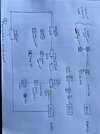Hi all,
First time poster. I’m currently designing a new kitchen and am trying to work out a logical electrical plan.
There is currently a ring main (2.5mm TE) and a radial (2.5mm TE) both RBD protected from the MCU supplying the kitchen. The combo boiler has already been moved onto its own radial.
I’ve called all the manufacturers and checked amperage and installation instructions (hardwire/plugged etc)
Main question was for the ovens. I initially had the 13 amp single oven on the ring but would prefer it to be on a dedicated radial with the microwave combi. Can these just be wired in series to backing plates or would you downfuse and put a 13amp FCU between them?
Any suggestions/amendments to the following plan? Had to do it the old fashioned way as my laptop has died..
Thanks in advance.
First time poster. I’m currently designing a new kitchen and am trying to work out a logical electrical plan.
There is currently a ring main (2.5mm TE) and a radial (2.5mm TE) both RBD protected from the MCU supplying the kitchen. The combo boiler has already been moved onto its own radial.
I’ve called all the manufacturers and checked amperage and installation instructions (hardwire/plugged etc)
Main question was for the ovens. I initially had the 13 amp single oven on the ring but would prefer it to be on a dedicated radial with the microwave combi. Can these just be wired in series to backing plates or would you downfuse and put a 13amp FCU between them?
Any suggestions/amendments to the following plan? Had to do it the old fashioned way as my laptop has died..
Thanks in advance.


